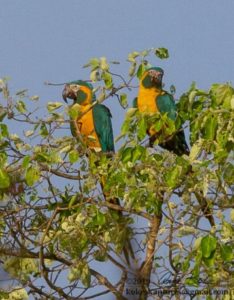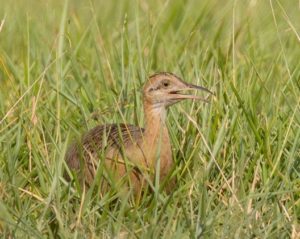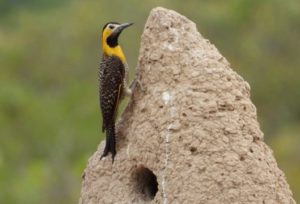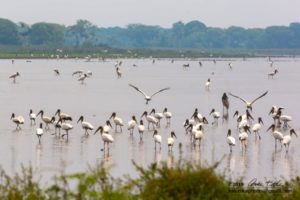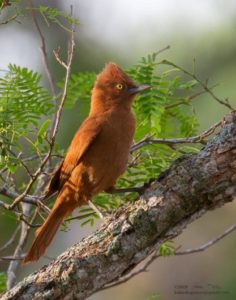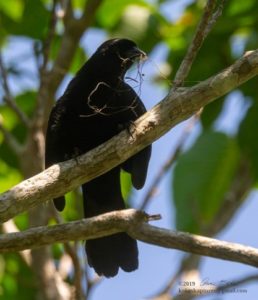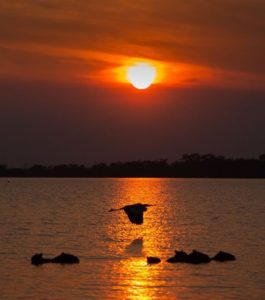Go to Andes and Chaco Lowlands bird tour page | Neotropical bird tours | Neotropical trip reports
DOWNLOAD TRIP REPORT
29 October – 4 November 2019
By Eduardo Ormaeche
Blue-throated Macaw, the main target of the tour
Overview
Our 2019 Bolivia trip was unfortunately cut short by civil unrest from a three-week trip to a one-week trip. The tour originally had been designed to provide the best of the entire country, as it normally does on our 21-day trip, including all major habitats such as the Chiquitano dry forests and the Beni lowlands, especially looking for the endemic and Critically endangered (IUCN) Blue-throated Macaw and all the Beni-endemic subspecies. Then we were to explore the beautiful, lush forest at Refugio Los Volcanes to look for a great set of birds, including the secretive Bolivian Recurvebill, Yungas Manakin, Ochre-cheeked Spinetail, Black-streaked Puffbird, Slaty Gnateater, and Military Macaw. Next we were to visit the dry Chaco near the Paraguayan border to look for Black-legged Seriema and explore the inter-Andean forests along the valleys to look for the endemic Red-fronted Macaw and other Bolivian endemics. After driving to Cochabamba to look for all Andean endemics, including Cochabamba Mountain Finch, we would finally fly to La Paz, where we would spend several days birding around Lake Titicaca, looking for Titicaca Grebe, and around the lush Yungas forest above La Paz to look for a great set of colorful tanagers, Diademed Tapaculo, and the striking Hooded Mountain Toucan.
However, our whole tour was affected by sudden civil unrest, which paralyzed the whole country. A few days before we arrived in Bolivia there had been presidential elections, and the incumbent leader Evo Morales was trying to keep himself in power for another five-year period, even though he was not the favorite contender. The elections showed many irregularities, as pointed out by local authorities and international observers. Apparently Morales’s opponent was winning, but after certain tricky incidents such as a general power cut in the country the results showed Morales to have won. The opposition parties and the entire Santa Cruz de la Sierra population shouted fraud and started demonstrations. Oh well, we arrived two days after the civil unrest had started, and we saw the whole population of Santa Cruz de la Sierra, not only political sympathizers but the entire civilian population, fighting to reestablish democracy in the country. This spoiled our whole trip, as we were not free to drive around the main roads in the country. All roads were blocked; however, we never felt threatened nor were we ever exposed to any dangerous situation, and there were many local people who apologized to us in English for the trouble that all this was causing us but also asked us to understand that they had to fight for their rights.
We managed to travel to the Beni province and had a great week of birding there with a fine series of good species, such as Greater Rhea, Campo Flicker, Great Rufous Woodcreeper, Red-billed Scythebill, Velvet-fronted Grackle, Plain Softtail, Grey-crested Cachalote, Blue-and-yellow, Chestnut-fronted, and Red-and-green Macaws, Sunbittern, Hoatzin, Bare-faced Curassow, hundreds of Jabirus and Wood Storks, Plumbeous, Green, Bare-faced, and Buff-necked Ibises, South American Snipe, White Monjita, White Woodpecker, Red-winged and Undulated Tinamous, and, most importantly, also our main target, the endemic and Critically endangered Blue-throated Macaw.
After a week in Beni we were forced to cancel the trip and return to our countries, because the demonstrations were becoming violent and towns started to experience shortages of basic supplies. We also certainly did not want to be involved in any skirmish between army and civilians. For us security was first, and so we abandoned the country. The demonstrations continued for about two months after we left and ended with the resignation of Morales, who asked for political asylum in Mexico and later in Argentina.
Bolivia is recovering gradually from its political crisis, and we will come back to get our revenge and find all the birds that this great country has to offer.
Detailed Report
Day 1, October 29th 2019. Arrival in Santa Cruz de la Sierra and transfer to the hotel
Our birding adventure started in the city of Santa Cruz de la Sierra, where the group arrived on different flights, and we met at the comfortable Hotel Cortez. We made plans for the next day and enjoyed a good meal together at the restaurant in the hotel.
Day 2, October 30th 2019. Birding around Santa Cruz de la Sierra
This was our first day trying to get out of a city with a national demonstration. It was absolutely tricky to find the way out of the city. The demonstration was generally all over the city, and the driver had to perform miracles to find his way through narrow streets to unpaved roads and dealing with lots of civilian checkpoints, but we managed to get out of the city in good time for birding.
We drove east of the city toward the shores of the Piray River, where we had a busy morning finding species such as Toco Toucan, White-wedged Piculet, Chopi Blackbird, Yellow-chevroned Parakeet, Gilded Sapphire, Pale-vented Pigeon, Guira Cuckoo, Rufous-tailed Jacamar, Chestnut-eared Aracari, Yellow-tufted Woodpecker, Blue-winged Parrotlet, Green-barred Woodpecker, White-crested Tyrannulet, Crowned Slaty Flycatcher, Purplish Jay, Sayaca Tanager, Purple-throated Euphonia, and Crested Oropendola.
We went to check a reservoir, where we managed to have great views of Ringed Teal, White-cheeked Pintail, White-winged Coot, Brazilian Teal, and Neotropic Cormorant. After a few minutes we left toward the shore of the Piray River. Here we saw good species such as Yellow-chinned Spinetail, Southern Lapwing, Picui Ground Dove, Fawn-breasted Wren, Southern Screamer, Brazilian Teal, Black-bellied Whistling Duck, Wattled Jacana, Limpkin, Solitary Sandpiper, Whistling Heron, White-tailed Kite, Black and Turkey Vultures, Rufous Hornero, Southern Crested Caracara, Southern Scrub Flycatcher, and Monk Parakeet.
After a tasty lunch in a private hacienda we headed back to the city to the Viru Viru International Airport, where after a drive around I spotted one of the main two targets for the afternoon, Red-winged Tinamou, and minutes later we saw Campo Flicker. We can say that, even though it had not been the original plan, we returned happy to the hotel with the hope that the social unrest could be fixed as fast as possible.
Red-winged Tinamou (photo Anne Koke)
Campo Flicker (photo John Trathen)
Day 3, October 31st 2019. Flight to and birding around Trinidad
We had another early start, leaving the hotel with enough time to get our domestic flight to Trinidad in the Beni state. Driving from the hotel to the airport took much longer than usual but was expected under the uncertain scenario we were witnessing in the country. The flight left without any problems, though, and we were in business. After arrival in Trinidad we met our local contact, who after some confusing minutes put us on the road directly to our hotel at the shores of the pretty Laguna Suárez outside the bustling town. After checking some birds around the hotel and getting our first lunch together as a group we left to explore the road to Loreto. The Beni lowlands in the Pampa de Moxos shows a complex mixture of habitats of grasslands, marshes, forest islands, and corridors of forests along waterways to look for one of the rarest birds in the world, the endemic and Critically endangered Blue-throated Macaw. Today it is only possible to find a few accessible spots in the Beni lowlands where the palms the macaw uses for nesting are still growing in good numbers. Our first day in the Beni lowlands was a blast. We had great views of species such as Plumbeous Ibis, Buff-necked Ibis, Southern Screamer, Greater Rhea, Southern Lapwing, Eastern Kingbird, Fork-tailed Flycatcher, Black-backed Water Tyrant, Cattle Tyrant, Yellow-chevroned Parakeet, Monk Parakeet, Chestnut-fronted Macaw, Wood Stork, Jabiru, Snail Kite, Black-collared Hawk, Whistling Heron, Great Egret, Snowy Egret, Limpkin, Chaco Chachalaca, and Ringed Kingfisher.
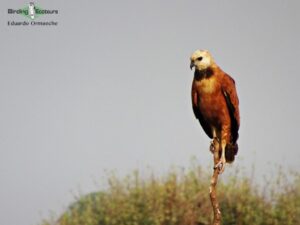
We found a huge wetland on one side of the road with one of the largest numbers of Wood Storks I have seen for years. It was also full of Jabirus, Wood Storks, Maguari Storks, South American Snipe, Collared Plover, and Baird’s, Pectoral, and Solitary Sandpipers. We also had views of Black-capped Donacobius, Yellow-chinned Spinetail, White-rumped Monjita, Crested Becard, Lesser Kiskadee, Turquoise-fronted Amazon, and Green Kingfisher. After this great experience we returned to Laguna Suárez and called it a day.
A convention of Wood Storks and Jabirus
Day 4, November 1st 2019. Birding along the Loreto road, search for Blue-throated Macaw
We had an early start leaving our base in Laguna Suárez to drive to the town of Loreto. Here we met our local contact, who led us to one of the haciendas along the Loreto road where the Blue-throated Macaw is quite reliable. We arrived at the hacienda, and the person in charge of visitors pointed out two potential stakeouts for the species. We could feel the excitement in the air when suddenly there was a pair of Blue-throated Macaws coming toward us and perched in a tree, where we could get great scope views. Sadly they did not stay around long enough to allow everybody to take a photo.
Birding around the hacienda we could add more species to the trip list, such as Narrow-billed Woodcreeper, White Woodpecker, Lineated Woodpecker, Streaked Flycatcher, Boat-billed Flycatcher, and Red-billed Scythebill.
It was getting warm already, so we birded outside the hacienda, finding Yellow-headed Caracara, Southern Crested Caracara, Ochre-faced Tody-Flycatcher, Common Tody-Flycatcher, Barred Antshrike, Mato Grosso Antbird, Red-and-green Macaw, and Toco Toucan. Then we returned to Laguna Suárez and spent the afternoon photographing birds around the hotel grounds, such as Grey-crested Cacholote, Orange-backed Troupial, and Greater Thornbird.
Grey-crested Cacholote
Even though the socio-political situation in Trinidad was calm we received a phone call from our airline saying that due to the recent demonstrations in Santa Cruz de la Sierra they decided to cancel our flight back to Santa Cruz de la Sierra for two days! So being literally trapped in Trinidad we were thankful about our comfortable hotel in Laguna Suárez away from all the political problems, but we also had to make alternative plans for the next two days. We had been hoping that after our return the demonstrations would be over and we would be able to continue with our itinerary, but after hearing from the airline I started to think that things could take longer to be fixed.
At night we tried to find a Spot-tailed Nightjar that was calling from the other side of the road, but unfortunately it did not come any closer and the terrain was quite inaccessible.
Day 5, November 2nd 2019. Birding Chuchini Amazon Wildlife Reserve
We decided to spend a morning looking for Beni specialists and found an accessible birding site near Trinidad called Chuchini Amazon Wildlife Reserve. Driving through Trinidad was no problem at all, and we arrived at the reserve rather quickly. There was good activity even outside the reserve, including species such as Snowy Egret, Great Egret, Cocoi Heron, a glimpse of Sunbittern, Large-billed Tern, Yellow-billed Tern, Grey-fronted Dove, Sayaca Tanager, Palm Tanager, Hoatzin, Blue-throated Piping Guan, White-winged Swallow, Southern Rough-winged Swallow, Ruddy Ground Dove, Picui Ground Dove, Greater Ani, Plumbeous Kite, Guira Cuckoo, Lesser Yellow-headed Vulture, Chestnut-fronted Macaw, and Roadside Hawk. Before getting into the reserve we found our targets, a nice flock of Velvet-fronted Grackles, which provide great views, and a Plain Softtail in a nest! Both are contenders for future splits; Beni Grackle and Beni Softtail would actually sound better!
Velvet-fronted Grackle
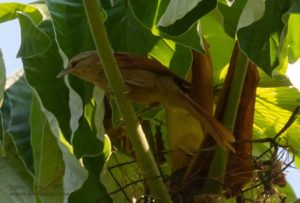
Then we entered the reserve and explored part of a trail, looking for a Great Potoo that we were told was roosting at daytime, but we could not find. It was slightly late and hot, so after a nice late-start morning we returned to the hotel, where we continued thinking about our strategies and options for the upcoming days.
Day 6, November 3rd 2019. Birding Chuchini Amazon Wildlife Reserve
We returned to the reserve early in the morning to explore the forest trails, and we saw a good set of birds including Spix’s Guan, Black-tailed Trogon, Blue-crowned Trogon, Black-fronted Nunbird, Yellow-billed Cuckoo, Velvet-fronted Grackle, Plain-crowned Spinetail, Chestnut-backed Antshrike, White-backed Fire-eye, Band-tailed Antbird, Black-throated Mango, White-chinned Sapphire, Buff-bellied Hermit, Olivaceous Woodcreeper, Buff-throated Woodcreeper, Great Rufous Woodcreeper, Band-tailed Manakin, White-eyed Attila, Yellow-olive Flatbill, Masked Tityra, and Black-crowned Tityra. In addition we had an enjoyable encounter with a pair of Undulated Tinamous coming toward us in response to the tape. We also found Rufous-tailed Jacamar, Crimson-crested Woodpecker, Golden-crowned Warbler, Fawn-breasted Wren, Orange-backed Troupial, Silver-beaked Tanager, White-winged Becard, White-eyed Parakeet, Purplish Jay, Short-crested Flycatcher, and Red-crested Cardinal, and sadly a shy male Bare-faced Curassow crossed the trail in front of us and was seen only by me and one participant.
After a full morning we returned to Trinidad, where we enjoyed lunch at the famous restaurant Churrasquería La Estancia. Then we went back to the lodge to prepare ourselves for the next day’s flight to Santa Cruz de la Sierra. In the late afternoon there was a wonderful view outside the hotel with a beautiful sunset, which was nicely captured by Anne.
Day 7, November 4th 2019. Flight to Santa Cruz de la Sierra, departure
After breakfast we transferred to the Trinidad airport to connect with our flight to Santa Cruz de la Sierra. When we arrived at Santa Cruz de la Sierra we were informed that the socio-political situation in Bolivia had become worse than we had expected, because the opposition and most of the Bolivian population had given the president 24 hours to resign, otherwise they threatened the government with an undefined strike that could turn serious and difficult for travelers. There was no way to continue with our itinerary, as the main roads were all blocked and the lack of basic supplies in the country-side lodges could be a potential risk in the following days. We feared that the situation could get even worse, and although we were very sad we decided to cancel our tour and change our flights to return to our respective countries. We spent the afternoon dealing with the airlines and changing our flights and managed to leave the country that very day.
Only five hours after we had left the civil unrest became worse in the whole country with skirmishes between the supporters of the opposition on the one hand and the army and police on the other. Nevertheless it is good to say that the civil unrest ended with the end of the government of Evo Morales and the country experienced a serious change of government, but the riots and demonstrations took over two months after we had left. So I guess we were lucky to have left on that day. There’s nothing else to say except that despite all the hassle, which was out of our hands, we managed to spent a great week and cleaned up the entire Beni region. We are happy to see that the situation is gradually improving, and we will return to Bolivia to claim vengeance and get all our missing birds!
Sunset at Laguna Suárez (photo Anne Koke)
BIRD LIST
Rheidae
Greater Rhea Rhea americana Seen in Trinidad and the Beni lowlands. Classified as Near-threatened. Here the subspecies araneipes
Tinamidae
Undulated Tinamou Crypturellus undulatus Great views of two individuals in the Chuchini Amazon Wildlife Reserve. Here the nominate subspecies. This species produces one of the most characteristic sounds in the Amazon rainforest and other tropical lowlands.
Tataupa Tinamou (H) Crypturellus tataupa Only heard in the Santa Cruz and Beni lowlands. Guaraní (Paraguayan) Indian name ynambu tataupá, “house tinamou”, for the Tataupa Tinamou because it occurs near villages and country haciendas
Red-winged Tinamou Rhynchotus rufescens Great views in the grasslands of the Viru Viru International Airport in Santa Cruz de la Sierra. Here the nominate subspecies
Cracidae
Chaco Chachalaca Ortalis canicollis Seen along the Loreto road. Here the nominate subspecies
Spix’s Guan Penelope jacquacu Seen in the Chuchini Amazon Wildlife Reserve. Named after Johann Baptist von Spix (1781-1826), German naturalist in Brazil 1817-1820 and author (Avitum species novae itinere Brazilian 1824)
Blue-throated Piping Guan Pipile cumanensis Seen in the Chuchini Amazon Wildlife Reserve. Here the subspecies grayi
Bare-faced Curassow Crax fasciolata Sadly seen by only one or two participants. A shy male flushed by us at one of the Chuchini Amazon Wildlife Reserve trails. The best place to see this species is the northern Pantanal in Brazil.
Anhimidae
Southern Screamer Chauna torquata Good views in the Beni lowlands along the Loreto road
Anatidae
Black-bellied Whistling Duck Dendrocygna autumnalis Several seen along the Loreto road
Muscovy Duck Cairina moschata A few noticed throughout the trip
Ringed Teal Callonetta leucophrys Great views of one pair at the reservoir near Santa Cruz de la Sierra
Brazilian Teal Amazonetta brasiliensis Seen at the reservoir near Santa Cruz de la Sierra and along the Loreto road. Here the subspecies ipecutiri
White-cheeked Pintail Anas bahamensis Seen in the Santa Cruz and Beni lowlands
Caprimulgidae
Spot-tailed Nightjar (H) Hydropsalis maculicaudus Heard near the Laguna Suárez but too far away from us
Trochilidae
Buff-bellied Hermit Phaethornis subochraceus Seen in the Beni lowlands. Found in Bolivia and adjacent Brazil
Black-throated Mango Anthracothorax nigricollis Seen in the Chuchini Amazon Wildlife Reserve
Gilded Sapphire Hylocharis chrysura Seen in the Santa Cruz lowlands
White-chinned Sapphire Hylocharis cyanus Seen at the Chuchini Amazon Wildlife Reserve
Cuculidae
Guira Cuckoo Guira guira Guaraní (Paraguayan) Indian name güira, a bird. Seen in the Santa Cruz and Beni lowlands
Greater Ani Crotophaga major Seen in the Beni lowlands
Smooth-billed Ani Crotophaga ani Seen in the Santa Cruz and Beni lowlands
Striped Cuckoo Tapera naevia Seen in the Beni lowlands
Squirrel Cuckoo Piaya cayana Seen in the Santa Cruz lowlands
Yellow-billed Cuckoo Coccyzus americanus Great views in the Chuchini Amazon Wildlife Reserve. A rare North American migrant in South America
Pheasant Cuckoo (H) Dromococcyx phasianellus Only heard in the Chuchini Amazon Wildlife Reserve
Columbidae
Rock Dove Columba livia Common
Picazuro Pigeon Patagioenas picazuro Seen in the Beni lowlands. Here the nominate subspecies. Guaraní (Paraguayan) Indian name picazuro, “sour pigeon”, from the taste of its flesh after it has eaten certain fruits
Pale-vented Pigeon Patagioenas cayennensis Seen in the Beni and Santa Cruz lowlands
Ruddy Ground Dove Columbina talpacoti Seen in the Beni lowlands
Picui Ground Dove Columbina picui Seen along Loreto road. Here the nominate subspecies. Guaraní (Paraguayan) Indian name picúi for a small dove
White-tipped Dove Leptotila verreauxi Seen in the Beni lowlands
Grey-fronted Dove Leptotila rufaxilla Seen in the Chuchini Amazon Wildlife Reserve
Eared Dove Zenaida auriculata Seen in Santa Cruz de la Sierra
Rallidae
Grey-necked Wood-Rail Aramides cajaneus Common in the Beni lowlands
White-winged Coot Fulica leucoptera A few at the Santa Cruz reservoir
Aramidae
Limpkin Aramus guarauna Seen in the Beni lowlands. Widespread from Florida to Argentina. Here the nominate subspecies
Recurvirostridae
White-backed Stilt Himantopus melanurus Seen at the Santa Cruz reservoir. Himantopus melanurus is split from H. mexicanus (Sibley & Monroe 1990, Ridgely & Greenfield 2001); SACC awaits more study.
Charadriidae
Southern Lapwing Vanellus chilensis Common in the Santa Cruz and Beni lowlands
Collared Plover Charadrius collaris Seen in the Beni lowlands
Jacanidae
Wattled Jacana Jacana jacana Seen in the Beni lowlands
Scolopacidae
Baird’s Sandpiper Calidris bairdii Seen in the wetlands along the Loreto road
Pectoral Sandpiper Calidris melanotos Seen in the wetlands along the Loreto road
South American Snipe Gallinago paraguaiae Seen in the wetlands along the Loreto road. Here the nominate subspecies
Solitary Sandpiper Tringa solitaria Seen in the wetlands along the Loreto road
Lesser Yellowlegs Tringa flavipes Seen in the wetlands along the Loreto road
Laridae
Yellow-billed Tern Sternula superciliaris Seen in the Beni lowlands
Large-billed Tern Phaetusa simplex Seen in the Beni lowlands
Eurypygidae
Sunbittern Eurypyga helias Brief views of one individual in the Chuchini Amazon Wildlife Reserve. A most-wanted species in the Neotropics
Ciconiidae
Wood Stork Mycteria americana 1000+ individuals were seen in the Beni lowlands.
Jabiru Jabiru mycteria Abundant in the Beni lowlands
Maguari Stork Ciconia maguari Great numbers in the Beni lowlands
Phalacrocoracidae
Neotropic Cormorant Phalacrocorax brasilianus Seen in the Beni lowlands. Widespread from USA to Tierra del Fuego
Threskiornithidae
Plumbeous Ibis Theristicus caerulescens Great views along the Loreto road
Buff-necked Ibis Theristicus caudatus Seen in the Beni lowlands
Bare-faced Ibis Phimosus infuscatus Seen in the Beni lowlands
Green Ibis Mesembrinibis cayennensis One seen in the Beni lowlands
Roseate Spoonbill Platalea ajaja Nice views in the Beni lowlands
Ardeidae
Rufescent Tiger Heron Tigrisoma lineatum Seen in Beni. Here the race marmoratum
Striated Heron Butorides striata Seen in the Beni wetlands
Western Cattle Egret Bubulcus ibis Several sightings
Cocoi Heron Ardea cocoi Seen in the Beni wetlands
Great Egret Ardea alba Seen in the Beni wetlands
Snowy Egret Egretta thula Seen in the Beni wetlands
Whistling Heron Syrigma sibilatrix Good views in Santa Cruz and Beni
Capped Heron Pilherodius pileatus Seen in the Beni wetlands
Opisthocomidae
Hoatzin Opisthocomus hoazin Seen in the Chuchini Amazon Wildlife Reserve in Beni. Nahuatl (Mexican) Indian name uatsin for some kind of large bird, probably not the Hoatzin, which does not occur in Middle America, but a gamebird. The name is said to be onomatopoeic in origin and has been variously transcribed as hoactzin, hoactli, hoatzin, hoacton, hoazin, heatotl and tobactli. Hernández (1615) gives hoactli and hoacton as Mexican Indian names for the adult and the young Black-crowned Night-Heron Nycticorax nycticorax respectively. The taxonomic position of this family has been greatly debated by specialists and is still far from clear. A whole genome sequencing study published in 2012 places the Hoatzin as the sister taxon of a clade composed of Gruiformes (cranes) and Charadriiformes (plovers). In 2015 genetic research indicated that the Hoatzin is the last surviving member of a bird line that branched off in its own direction 64 million years ago, shortly after the extinction of the dinosaurs.
Cathartidae
Turkey Vulture Cathartes aura Seen in Santa Cruz and the Beni
Lesser Yellow-headed Vulture Cathartes burrovianus Seen in the Beni grasslands
Black Vulture Coragyps atratus Common
Pandionidae
Western Osprey Pandion haliaetus Only one sighting in the Beni lowlands
Accipitridae
White-tailed Kite Elanus leucurus Good views in the Beni lowlands
Plumbeous Kite Ictinia plumbea Seen in the Beni lowlands
Black-collared Hawk Busarellus nigricollis Nice views in the Beni lowlands
Snail Kite Rostrhamus sociabilis Several sightings in the Beni lowlands. Here the nominate subspecies
Slender-billed Kite Helicolestes hamatus Seen in the Beni lowlands
Great Black Hawk Buteogallus urubitinga Common in the Beni lowlands
Savanna Hawk Buteogallus meridionalis Seen in the Beni grasslands
Roadside Hawk Rupornis magnirostris Seen in the Beni lowlands
White-tailed Hawk Geranoaetus albicaudatus Seen in the Beni lowlands
Strigidae
Burrowing Owl Athene cunicularia Seen in the Beni lowlands
Trogonidae
Blue-crowned Trogon Trogon curucui Seen in the Chuchini Amazon Wildlife Reserve. Here the subspecies behni
Black-tailed Trogon Trogon melanurus Seen at the Chuchini Amazon Wildlife Reserve. Here the nominate subspecies
Alcedinidae
Green Kingfisher Chloroceryle americana Seen in the Beni lowlands
Ringed Kingfisher Megaceryle torquata Seen in the Beni lowlands
Galbulidae
Rufous-tailed Jacamar Galbula ruficauda Seen in the Beni lowlands
Bucconidae
Black-fronted Nunbird Monasa nigrifrons Seen in the Chuchini Amazon Wildlife Reserve. Here the endemic subspecies canescens
Ramphastidae
Chestnut-eared Aracari Pteroglossus castanotis Seen around Santa Cruz de la Sierra. Here the subspecies australis. Tupi (Brazilian) Indian name arasari for a small toucan (Portuguese spelling araçari)
Toco Toucan Ramphastos toco Seen in the Santa Cruz and Beni lowlands. Here the subspecies albogularis
Picidae
White-wedged Piculet Picumnus albosquamatus Seen in the Santa Cruz and Beni lowlands. Here the nominate subspecies
White Woodpecker Melanerpes candidus Great views in the Beni lowlands
Yellow-tufted Woodpecker Melanerpes cruentatus Seen in the Chuchini Amazon Wildlife Reserve
Green-barred Woodpecker Colaptes melanochloros Seen in the Santa Cruz and Beni lowlands
Campo Flicker Colaptes campestris Seen in the Santa Cruz lowlands including the grasslands around the international airport
Lineated Woodpecker Dryocopus lineatus Seen in the Loreto haciendas
Crimson-crested Woodpecker Campephilus melanoleucos Seen in the Beni lowlands
Falconidae
Yellow-headed Caracara Milvago chimachima Seen in the Beni lowlands
Southern Crested Caracara Caracara plancus Seen in Santa Cruz and Beni lowlands
Aplomado Falcon Falco femoralis A nice pair seen near the entrance of the Chuchini Amazon Wildlife Reserve
Psittacidae
Blue-throated Macaw Ara glaucogularis Great views of a pair in the Loreto haciendas. This is a Bolivian endemic. A Critical endangered species. In 2014 this species was designated by law has a natural patrimony of Bolivia, where it is known as barba azul, which means ‘blue beard’ in Spanish. Recent population and range estimates suggest that about 350–400 individuals remain in the wild. The main cause of their demise is capture for the pet trade. The blue-throated macaw lives in the Llano de Moxos of the Beni Department of Bolivia, nesting in “islas” (islands) of palm trees that dot the level plains. It is not a forest-dwelling bird. This species is one of the rarest in the world. There are two areas inhabited by two subpopulations of Ara glaucogularis: one is to the northwest of Trinidad (the capital city of Beni), and the other is to the south of Trinidad. This complex landscape consists of grasslands, marshes, forest islands, and corridors of forests along waterways. They occur most often between the elevations of 200 and 300 meters (656 and 984 feet). It was rediscovered only in 1992.
Blue-and-yellow Macaw Ara ararauna Nice views along the Loreto road
Red-and-green Macaw Ara chloropterus Two birds were seen along the Loreto road.
Chestnut-fronted Macaw Ara severus Good views in the Beni lowlands
Dusky-headed Parakeet Aratinga weddellii Seen in the Chuchini Amazon Wildlife Reserve
White-eyed Parakeet Psittacara leucophthalmus Seen in the Trinidad and the Chuchini Amazon Wildlife Reserve
Peach-fronted Parakeet Eupsittula aurea Great views in the Beni lowlands
Monk Parakeet Myiopsitta monachus Seen in the Santa Cruz and Beni lowlands
Blue-winged Parrotlet Forpus xanthopterygius Seen in the Beni lowlands
Yellow-chevroned Parakeet Brotogeris chiriri Common in the Santa Cruz and Beni lowlands
Turquoise-fronted Amazon Amazona aestiva A few sightings in the Beni lowlands
Furnariidae
Olivaceous Woodcreeper Sittasomus griseicapillus Seen in the Chuchini Amazon Wildlife Reserve. Here the subspecies griseicapillus. Keep track of your sightings of this species, as it is a contender for a potential split, and probably five different species will be split from this one. Widespread from Mexico to Argentina
Wedge-billed Woodcreeper Glyphorynchus spirurus Seen in the Chuchini Amazon Wildlife Reserve. Here the subspecies albigularis
Buff-throated Woodcreeper Xiphorhynchus guttatus Seen in the Chuchini Amazon Wildlife Reserve
Narrow-billed Woodcreeper Lepidocolaptes angustirostris Good views in the Beni hacienda
Great Rufous Woodcreeper Xiphocolaptes major Seen at the Chuchini Amazon Wildlife Reserve. Here the subspecies castaneus
Red-billed Scythebill Campylorhamphus trochilirostris Great views in the Beni hacienda. Always a pleasure to see. Widespread from Panama to Argentina. Here the subspecies lafresnayanus
Rufous Hornero Furnarius rufus Seen in Santa Cruz and Beni. This is the national bird of Argentina. The derivation of the generic name, Furnarius, is from the Latin furnus, meaning “oven”. The Spanish word “hornero” similarly comes from Spanish horno, meaning “oven” Hornero means “oven maker”.
Plain Softtail Thripophaga fusciceps Great views in the Beni lowlands. Here the nominate subspecies. Between subspecies there are differences in behaviors like family nesting, vocalization, habitat, and nesting; these make the species a contender to be split, as many authorities agree.
Plain-crowned Spinetail Synallaxis gujanensis Seen in the Chuchini Amazon Wildlife Reserve
Yellow-chinned Spinetail Certhiaxis cinnamomeus Seen in the Santa Cruz and Beni lowlands
Greater Thornbird Phacellodomus ruber Seen in the grounds of our hotel at Laguna Suárez
Grey-crested Cacholote Pseudoseisura unirufa A recent split from Rufous Cachalote. Seen in the Beni lowlands and at our hotel in Lago Suárez as well. The population here lacks the grey crest.
Thamnophilidae
Great Antshrike Taraba major Seen in the Beni lowlands
Barred Antshrike Thamnophilus doliatus Seen in the Beni lowlands
Chestnut-backed Antshrike Thamnophilus palliatus Seen in the Chuchini Amazon Wildlife Reserve
Mato Grosso Antbird Cercomacra melanaria Good views in the Beni lowlands. Named after the Brazilian state of Mato Grosso
White-backed Fire-eye Pyriglena leuconota Great views in the Chuchini Amazon Wildlife Reserve
Band-tailed Antbird Hypocnemoides maculicauda Good views of one pair in the Chuchini Amazon Wildlife Reserve
Tyrannidae
Yellow-bellied Elaenia Elaenia flavogaster Seen in the Beni lowlands
White-crested Tyrannulet Serpophaga subcristata Seen in the Chuchini Amazon Wildlife Reserve
Mouse-colored Tyrannulet Phaeomyias murina Seen in the Chuchini Amazon Wildlife Reserve
Southern Scrub Flycatcher Sublegatus modestus Seen in the Beni lowlands
Ochre-faced Tody-Flycatcher Poecilotriccus plumbeiceps Good views in one of the haciendas along the Loreto road
Common Tody-Flycatcher Todirostrum cinereum Seen in Santa Cruz and Beni
Yellow-olive Flatbill Tolmomyias sulphurescens Seen in the Chuchini Amazon Wildlife Reserve
Scarlet Flycatcher Pyrocephalus rubinus Seen in Santa Cruz and Beni. Scarlet Flycatcher (P. rubinus) is split from Vermilion Flycatcher (now P. obscurus). Original English name preferred to Austral Vermilion Flycatcher. (Carmi et al. 2016)
White-rumped Monjita Xolmis velatus Great views in Beni
White Monjita Xolmis irupero Great views in Beni
Black-backed Water Tyrant Fluvicola albiventer Seen in the Beni wetlands
White-headed Marsh Tyrant Arundinicola leucocephala Seen in the Beni wetlands
Cattle Tyrant Machetornis rixosa Seen in the Beni lowlands
Social Flycatcher Myiozetetes similis Seen in the Beni
Great Kiskadee Pitangus sulphuratus Common in the lowlands
Lesser Kiskadee Philohydor lictor Seen in the Beni wetlands
Streaked Flycatcher Myiodynastes maculatus Seen in the Santa Cruz and Beni lowlands
Boat-billed Flycatcher Megarynchus pitangua Seen in the Beni lowlands
Piratic Flycatcher Legatus leucophaius Seen in the Chuchini Amazon Wildlife Reserve. It got its name because it does not build its own nest but appropriates the domed or enclosed nests of other, often far larger, bird species, such as Yellow-rumped Cacique or Crested Oropendola. Once the persistence of the flycatchers has driven the rightful owners away, their eggs are removed and the female flycatcher lays up to four, but usually two, black-streaked brown eggs.
Short-crested Flycatcher Myiarchus ferox Seen in the Beni lowlands
Eastern Kingbird Tyrannus tyrannus Great views in the Santa Cruz lowlands
Tropical Kingbird Tyrannus melancholicus Common
Crowned Slaty Flycatcher Griseotyrannus aurantioatrocristatus We had our first encounter in the lowlands of Santa Cruz.
Fork-tailed Flycatcher Tyrannus savana Several noted in the Santa Cruz and Beni lowlands, where more than 20 individuals were recorded on different occasions, the same as on our previous Brazil tour, where we also saw more than 20 in the Pantanal.
White-eyed Attila Attila bolivianus Great views along the Loreto road. The bird is also known as Dull-capped Attila. Named after Attila (406-453), the “Scourge of God”, king of the hunnish hordes that ravaged Europe in the fifth century
Pipridae
Band-tailed Manakin Pipra fasciicauda Good views in the Chuchini Amazon Wildlife Reserve
Tityridae
Masked Tityra Tityra semifasciata Seen in the Chuchini Amazon Wildlife Reserve
Black-crowned Tityra Tityra inquisitor Seen in the Beni lowlands
Crested Becard Pachyramphus validus Seen in the Beni haciendas
White-winged Becard Pachyramphus polychopterus Seen in the Beni lowlands
Corvidae
Purplish Jay Cyanocorax cyanomelas Seen in the Beni lowlands
Curl-crested Jay Cyanocorax cristatellus Seen in the Beni lowlands
Hirundinidae
White-rumped Swallow Tachycineta leucorrhoa Seen in the Santa Cruz lowlands
White-winged Swallow Tachycineta albiventer Seen in the Beni lowlands
Grey-breasted Martin Progne chalybea Seen in the Beni and Santa Cruz lowlands. Here the subspecies macrorhamphus
Brown-chested Martin Progne tapera Seen in the Beni lowlands
Barn Swallow Hirundo rustica Seen along the Loreto road
Southern Rough-winged Swallow Stelgidopteryx ruficollis Seen in the Chuchini Amazon Wildlife Reserve
Donacobiidae
Black-capped Donacobius Donacobius atricapilla Seen in the Beni lowlands. Here the subspecies albovittatus
Troglodytidae
Thrush-like Wren Campylorhynchus turdinus Seen in the Santa Cruz lowlands
Fawn-breasted Wren Cantorchilus guarayanus Seen in the Santa Cruz lowlands. Found in Bolivia and adjacent Brazil
House Wren Troglodytes aedon Common
Polioptilidae
Masked Gnatcatcher Polioptila dumicola Seen in the Beni lowlands
Mimidae
Chalk-browed Mockingbird Mimus saturninus Seen in Santa Cruz and Trinidad. Here the subspecies modulator
Turdidae
Black-billed Thrush Turdus ignobilis The common thrush in the lowlands
Hauxwell’s Thrush Turdus hauxwelli one recorded at the Chuchini Amazon Wildlife Reserve
Passeridae
House Sparrow Passer domesticus Seen in Santa Cruz de la Sierra
Fringillidae
Purple-throated Euphonia Euphonia chlorotica Seen in the Santa Cruz and Beni lowlands
Passerellidae
Grassland Sparrow Ammodramus humeralis Good views in the Beni grasslands
Icteridae
Crested Oropendola Psarocolius decumanus Seen in the Santa Cruz and Beni lowlands
Yellow-rumped Cacique Cacicus cela Seen in the Santa Cruz and Beni lowlands
Orange-backed Troupial Icterus croconotus Seen in the Beni lowlands
Velvet-fronted Grackle Lampropsar tanagrinus Great views in Chuchini Amazon Wildlife Reserve. Here the endemic subspecies boliviensis, which is a potential split and is considered another Beni specialist
Chopi Blackbird Gnorimopsar chopi Common in Santa Cruz and Beni
Unicolored Blackbird Agelasticus cyanopus A pair was seen in the wetlands along the Loreto road.
Greyish Baywing Agelaioides badius Seen in Beni
Shiny Cowbird Molothrus bonariensis Seen in Santa Cruz, Trinidad and Beni
Giant Cowbird Molothrus oryzivorus Seen in the Beni lowlands
Parulidae
Golden-crowned Warbler Basileuterus culicivorus Seen in the Chuchini Amazon Wildlife Reserve
Thraupidae
Red-crested Cardinal Paroaria coronata Seen in the Beni lowlands
Yellow-billed Cardinal Paroaria capitata Seen in the Beni lowlands
Hooded Tanager Nemosia pileata Brief views along the Loreto road
Silver-beaked Tanager Ramphocelus carbo Seen in the Chuchini Amazon Wildlife Reserve
Sayaca Tanager Thraupis sayaca Seen in Santa Cruz, Trinidad and Beni. The Tupí (Brazilian) Indian name sayacu is for a type of finch.
Palm Tanager Thraupis palmarum Seen in Santa Cruz and the Chuchini Amazon Wildlife Reserve
Red Pileated Finch Coryphospingus cucullatus Good views in the Beni lowlands
Pampa Finch Embernagra platensis Seen in the Beni lowlands. Slight plumage variation and song variation might suggest that the population in Beni could be a contender for subspecies status or even a potential split.
Saffron Finch Sicalis flaveola Common
Rusty-collared Seedeater Sporophila collaris Seen in the Beni lowlands. Here the subspecies ochrascens
Greyish Saltator Saltator coerulescens Seen in the Santa Cruz and Beni lowlands. Widespread from Mexico to Argentina. Here the nominate subspecies
WILDLIFE
Capybara Hydrochoerus hydrochaeris
Olalla Brothers’ Titi Callicebus olallae This species of titi monkey is restricted to the Beni River basin and some of its tributaries. We had good but brief views of one, which allowed us to see its rich, brown color, which differs from that of the other species of titi found in Santa Cruz.
Bolivian Gray Titi Callicebus donacophilus A Bolivian endemic
South American Coati Nasua nasua Seen in the Beni lowlands
Tayra Eira barbara Seen by only a few participants in the Beni lowlands
Yacaré Caiman yacare Seen in the Beni wetlands
Black-and-white Tegu Salvator merianae Seen in the Chuchini Amazon Wildlife Reserve
